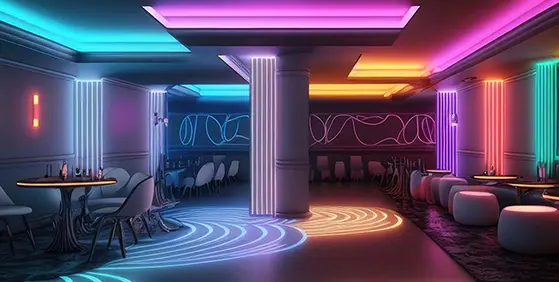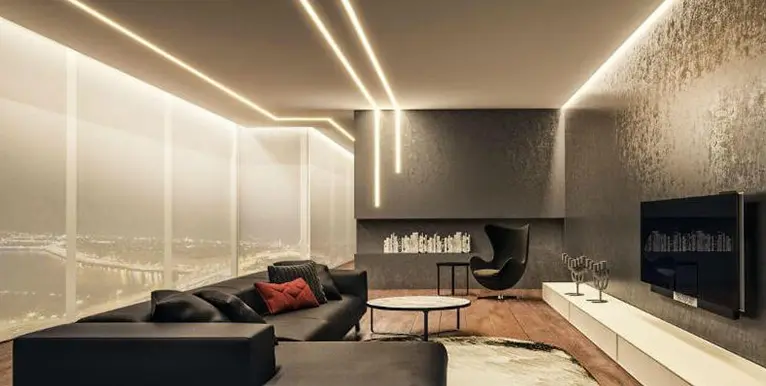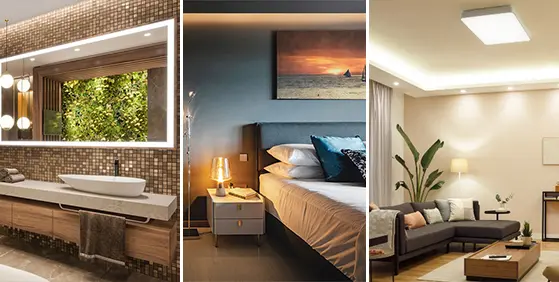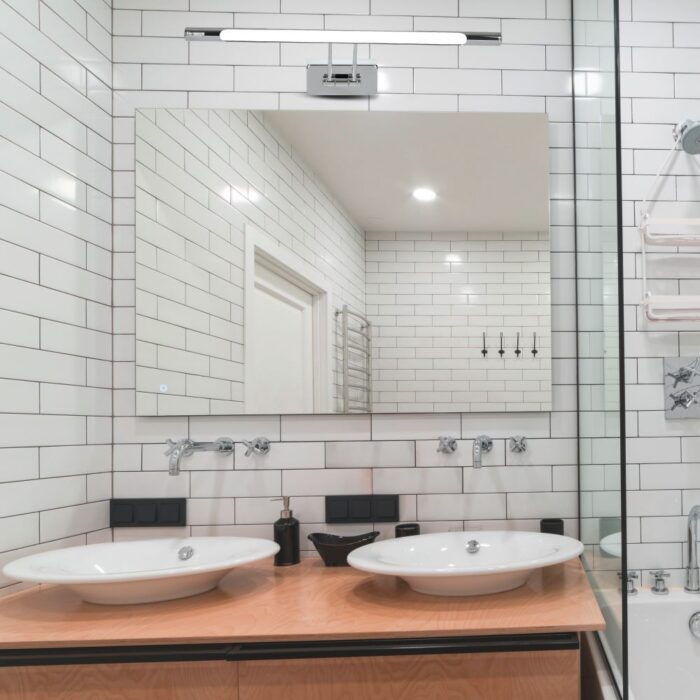For what’s usually quite a small space, lighting a bathroom or shower room can be surprisingly complicated. It’s a tricky task of balancing ambient lighting with task lighting and with all that water splashing about, you have to consider safety first.
What’s the best lighting to have in a bathroom?
The answer is safe lighting.
IP (Ingress Protection or International Protection) ratings define the degree of protection that electrical fittings, including lightbulbs, provide against intrusion by moisture. Consequently, the IP rating is also known as the damp rating and can refer to wind and rain for outdoor lights or water and steam for bathroom lighting.
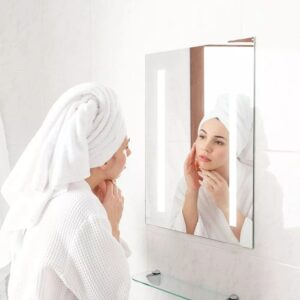

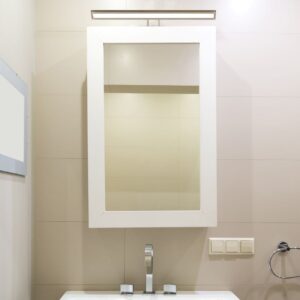
Bathrooms are divided into zones for the purpose of identifying the required IP rating:
Zone 0: This zone is inside the bath or shower itself. Any fitting used in this zone must be a maximum of 12v and rated at least IP67 – total immersion proof.
Zone 1: This is the area above the bath or shower, up to a height of 2.25m. A minimum rating of IP45 is required but it is a rule of thumb that IP65 should be used.
Zone 2: Stretching 0.6m outside the edge of the bath and up to 2.25m from the floor. Here an IP rating of at least IP44 is required. It’s also sensible to consider the area around a wash basin as being Zone 2 as well as a 60cm radius from any tap.
There are no special IP requirements outside of these zones, but, it’s a good idea to use lighting with an IP rating of at least IP20+ and in any area where water jets might be used, say for cleaning, then a minimum of IP65 rated lighting must be used.
In the UK, only a 12v socket is allowed in a bathroom. While LED lighting can operate on 12v it is not recommended to use plug-in lighting in the bathroom as they could easily be knocked over.
In the US, Ground Fault Circuit Interruption (GFCI) rules apply to domestic electrical installation.
If the lights over your tub or shower are recessed lights or any other light fixture that is waterproof, they may not need GFCI. However, it is always safer to make sure your lights are GFCI-protected.
Which LED lights are best for a bathroom?
LED lighting now comes in all fitting types so can be used anywhere in the bathroom that older, more conventional lightbulbs could.
In some cases, it will be possible to do a direct swap from old incandescent or fluorescent lights to longer-lasting and far more energy-efficient LEDs. In other cases, you may need an electrician to swap out fittings, such as for some IP-rated lights.
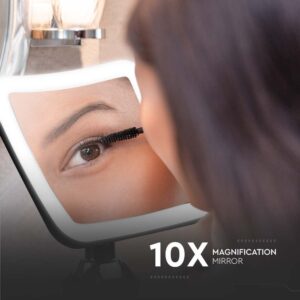
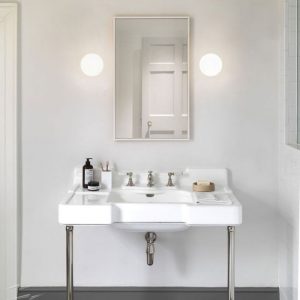
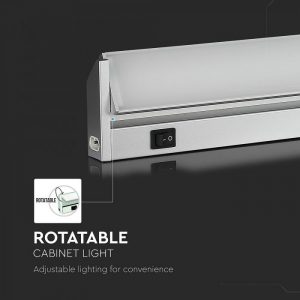
In general pendant lights should be avoided in the bathroom as recessed lighting, especially in the ceiling gives a smoother look, is easier to clean and offers better protection from moisture. As many bathrooms are small, a pendant light hanging down will make it feel even smaller.
What colour LED for bathrooms?
For task lighting above a vanity or mirror, for instance, use bluer white with a higher Kelvin (K) rating. These give the best clear white light for getting things done. But if you want to use your bathroom as a relaxing spa at the end of the day then coloured LED lighting can really help.
A lot of research has been done into how coloured lighting can affect your mood and despite some conflicting results, the consensus is that reds and pinks are calming colours that soothe the mind. Green is calming but is thought to provoke wakefulness while blue is the tricky one. A brighter blue/white is definitely a colour that promotes alertness (hence its use in task lighting) but a softer purple/blue promotes restfulness. Coloured LED lights can be controlled to emit whichever colour combination your body desires.
It’s no problem to have both blue/white task lighting and calming colours in one bathroom as long as each light has a separate switch so you can change from mood to task in an instant.
How many lumens should a bathroom light be?
Take a look at some of our other posts for a full explanation of Lumens, Lux and Watts. Suffice it to say here that Lumens measure the amount of light emitted by a bulb and the recommended Lumens for a relaxing ambient light is around 100 Lumens per square meter, whereas 300 Lumens per square meter for a “work” room.
Your bathroom functions as both a relaxation and a workroom so a combination of Lumen spread around the room should work well.

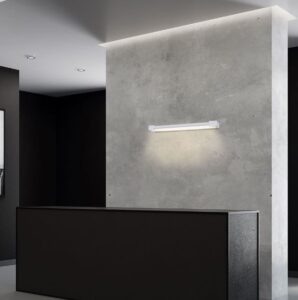
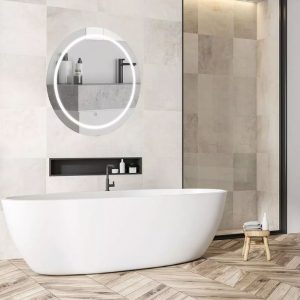
What is the best way to light a bathroom mirror?
The bathroom mirror is the ultimate task lighting location so needs to be well-lit. Traditionally an overhead-mounted, chrome wall lamp works great but these days there are more options. Think about a mirror with integrated LEDs for a sleeker, more modern look.
FAQs
Can you put LED lights above the shower?
Yes, you can. They should be appropriately IP-rated for Zone 1 as mentioned above so at least IP45 but IP65 is recommended. Recessing a shower light in the ceiling or integrating it into an extractor fan gives added protection from steam and moisture.
Should bathroom lights face up or down?
As a rule, up-lighting should be avoided in the bathroom as at a low level, it can accumulate spilt water and become a hazard, and at a high level, it could accumulate moisture from steam. Consider recessed ceiling lights as a more practical alternative.
Can I put LED strip lights in my bathroom?
Provided they are not plugged into a socket, strip lighting is a great way to add accent lighting in a bathroom. Use it under a vanity or other plinths to give a floating look to otherwise heavy-looking units.
Whatever you use your bathroom for, contact us and we’ll be happy to talk through all the different choices we have to light your bathroom.

